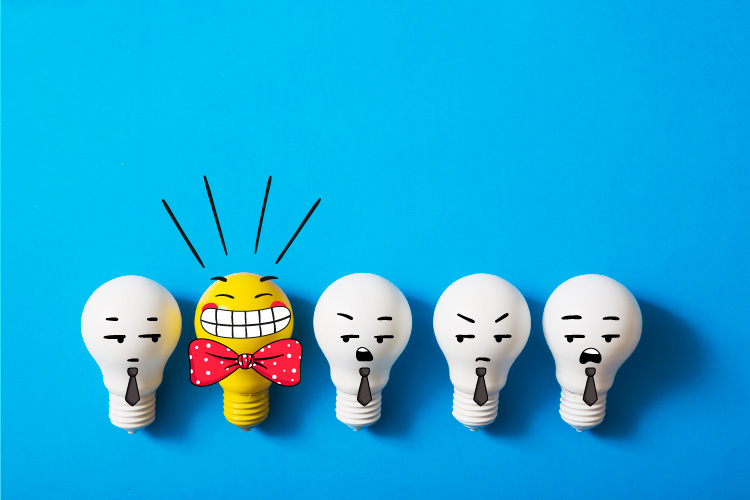Jan Becker, Norman Cousins, and Ramin Assemi may have never met, but they have something in common: they all believed in the power of smiling. “A day without a smile is a lost day,” is how comedian Charly Chaplin is attributed as a quote. And Mother Theresa, who was a benefactor in the poor slums of Calcutta, recommended: “Smile five times a day to a person you don’t want to smile at. Because peace begins with a smile.”
Smiles spark a force in us

They were all right. Smiles spark a force in us that can heal and straighten us up. A smile connects people. A baby smiles about 400 times a day, an adult only 15 times on average. The numbers may vary in the literature, but the ratio remains roughly the same. Norman Cousins, science journalist and peace activist, saw through the beneficial mechanism of the smile and tried out for himself how a smile or a strong laugh could relieve his pain for a few hours. Because Cousins suffered from a very painful, chronic inflammation of the spine, which was aggravated by a negative state of mind. When he laughed a lot and heartily, for example by watching funny films, this had a positive effect on the pain receptors – the pain was gone for a few hours. His discovery, which he made in the early 1970s, underpinned the then young science of laughter research, gelotology.
19 variants of smile

Cousin’s smile experiment is still contagious. Jan Becker, contemporary author and hypnosis trainer, describes Cousin’s experiences in his new book “Relaxed you can do everything” as a reference for smiling as the cornerstone of an inner relaxed attitude. He also recommended an exercise from laughter yoga, focusing on the smile, in order to get in the right mood for a mental self-hypnosis program that can promote this desired relaxed inner attitude. If you smile, you get – mostly – a smile, that’s the idea. This also applies to you. Science distinguishes 19 different types of smile. For example, there is a smile of joy or happiness. The satisfied smile. But also, the cold, sardonic smile, a smile from anger, or from politeness or embarrassment.
Only the “honest” smile has a positive effect, that is, the spontaneous raising of both corners of the mouth up to the eyes, around which a small crow’s feet settle in seconds. At least 52 muscles are involved. If the smile impulse affects the entire body and there is a very good mood and even a hearty laugh, then even 135 muscles, from the eyes to the diaphragm, are active. Endorphins are released, stress hormones in the blood are lowered, gas exchange in the lungs is increased by up to 400 percent. Blood vessels relax and blood pressure drops when there is reason to celebrate. It’s good for the heart. Numerous studies have shown these positive effects. For example, in this study conducted by Invisalign in London, Britons who laughed more often with their senior execs were promoted 70% times more than those who didn’t share that rapport with their boss or senior colleague. Smile can indeed change your career or your life if we put it other way.
Good for the immune system

Have you watched a funny video today? Then go and watch one, because laughing improves the immune system. When laughing, the body produces more immunoglobulins A. These protect against germs. The number of B lymphocytes in the blood also increases significantly. In addition, the number of natural killer cells in the blood increases, and more T helper cells are activated. The endothelium, the cell layer of the inner blood and lymphatic vessels, expands and thus improves the transport of blood through the body.
Acts as a medicine for stress

Laughter releases endorphins and suppresses the release of the stress hormones cortisol and adrenaline. If you laugh, you reduce stress and often discover new approaches to problems that cause stress. Creativity is also aroused by laughter, and better and faster solutions are found, scientists say. The heart muscle also benefits: A hearty laugh trains the heart muscle in about 15 minutes on a bicycle exercise bike or 10 minutes on a rowing machine.
A smile is therefore a catalyst for good health, at least for the moment, sometimes also in the long term. But it is also a sign of peaceful intentions and therefore a form of non-verbal communication. Ramin Assemi, an exile German in Thailand, describes on his website, a self-experiment that he carried out on the Berlin subway. Because he wanted to counter the displeasure of the passengers’ faces in the morning with something positive, he simply smiled at people for no reason, just to start the day with a good feeling for his own sake. His experience coincides with the knowledge of research: “It is much easier to give a smile to other people than to get one back.” There is much more smile in Thailand than in Berlin. His realization: “Just keep smiling. It’s easier to have a positive charisma than to hold up a shield against negative emotions.”
But do we laugh when we smile? Basically, the smile is innate and is understood by all human cultures Guillaume Benjamin Duchenne, physiologist and neurologist from Austria, stimulated the facial muscles of his human subjects in the mid-19th century via electrodes with electrical current. He discovered the “muscle of joy”, the large zygomatic muscle that is always involved in a real smile in addition to the described eye ring muscle. If only the zygomatic muscles move, the smile is fake. Even today, the real smile is called “Duchenne smile”.
Ultimately, it doesn’t matter whether you outsmart yourself and laugh with an artificial smile, or whether you laugh heartily. Students of the bachelor’s degree course “Vocational Education in Health Care” at the Department of Health at Münster University of Applied Sciences got to the bottom of the difference between smiling and laughing in a small self-study. The results were published in a book that is now also part of the canon of teaching material in nursing. “Laughter makes you happy – laughter makes you healthy” is the conclusion of the book. And the clown doctors, who heal with humor instead of syringes, are perhaps the most beautiful answer in gelotology to the question,


